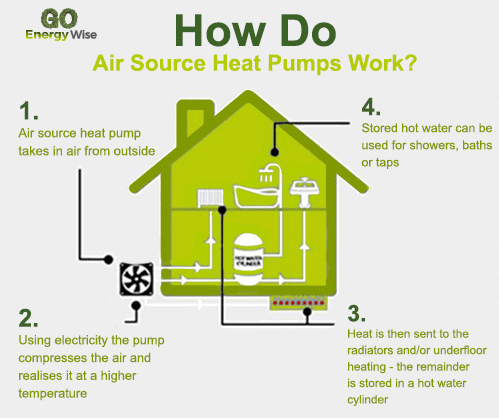Air source heat pumps are a form of renewable energy technology which take the warmth from the air outside (even when it’s quite cold) and use it to heat the home. Air-To-Water systems heat water which is then circulated around the home via radiators or an underfloor heating system.
We appreciate that there are a lot factors to consider when deciding if a heat pump is the right choice for you. Please be reassured we are here to help guide you through this process and select the right heat pump for you. The best way we have found is to arrange a time for us to call you and discuss your requirements and talk you through the information we require to be able to provide you with the best solution for you and then to be able to produce an estimate. The renewable heat incentive is available for heat pumps but these installations must be MCS compliant.
There are numerous benefits to using heat pumps, which is a renewable alternative to heat your home in the UK. With an air source heat pump, you can save money on your energy bills and reduce your carbon footprint compared to gas or oil heating system.
The main difference between a heat pump and conventional boiler is that the heat pump produces a lower flow temperature. This means that the heat pump has to be correctly sized. This is achieved by carrying out an accurate heat loss of the property. Because of the lower flow temperature this also means that a percentage of the radiators will need to be increased in size. The domestic hot water cylinder will also need to be changed to one with a bigger coil to enable the heat to be transferred into the water at a lower flow temperature.
HT heat pumps have been designed to operate at 80 degrees and so can heat standard radiators. Other advanced heat pumps operate up to 65 degrees and are also good candidates for existing heating systems. This means that less radiators and in some cases none will need replacing.
The disadvantages are that high temperature heat pumps are more expensive to fit and less efficient than low temperature models. The higher temperature is achieved by installing two heat pumps with a refrigerant circuit between the two. This also means you need a space to install the indoor unit its about the size of a dishwasher and this unit will create some noise similar to a washing machine when in use and needs to be situated where the noise will not be a disturbance .
These type of systems allow more flexibility in the positioning of the heat pump. This is again two heat pumps connected with refrigerant pipe work. This means that the external unit can be situated further away and because of the refrigerant circuit there are no heat losses on the connecting pipe work.
Hybrid heat pumps, often referred to as bivalent heat pumps, essentially comprise a heat pump and another heat source (such as a boiler) that are combined into one system.
Hybrid solutions are part of the future of heating n our homes, especially in the push towards net zero, and as our heating systems change we will likely see a rapid increase in the uptake of these systems.
A hybrid heat pump will change between the two different heat sources according to predetermined settings. You could choose to have your boiler providing the hot water and the heat pump providing space heating, for example. Or the boiler could be set up to cover both the space heating and hot water demand, and the heat pump could be used when the efficiency is higher (and it is cheaper) — it can then be changed over to the boiler when the outside temperature drops.
This also means you do not have to change your radiators and depending on the set up you may be able to keep your domestic hot water cylinder.

Domestic households can claim up to a huge £11,200. This figure is index linked, tax free and paid quarterly over the course of 7 years.
There are certain criteria’s that have to be met in order to be eligible for this funding.
You must have had an Electronic Performance Certificate within the past 2 years which requires the following:
1. 300mm of loft insulation as a minimum. 25% of heat can be lost through an uninsulated roof.
2. Any cavity walls to be filled. 35% on average is lost through uninsulated walls.
3. An application to the District Network Operator must also be done by yourself however we can help you through this process.
To calculate your own dwellings potential payback go to the RHI calculator website. The scheme has been up and running since 2014 however is coming to a halt by the end of march 2022 for domestic households.
This was set up in 2014 to kickstart and encourage developers or homeowners to install a renewable heating source. Boilers are being phased out and after 2025 boilers cannot be installed into new builds. This incentive has influenced a skyrocket in heat pump technology,
in particular by Vaill Domestic households can claim up to a huge £11,200. This figure is index linked, tax free and paid quarterly over the course of 7 years.
As we saw with solar panels these schemes do come to an end once a certain level of instillation has been reached.
The domestic RHI finishes by the end of march 2022.
The non-domestic RHI ends a year earlier, end of march 2021.


